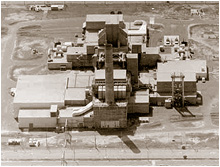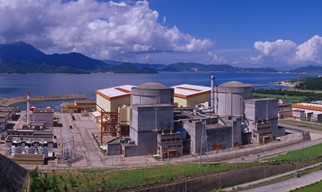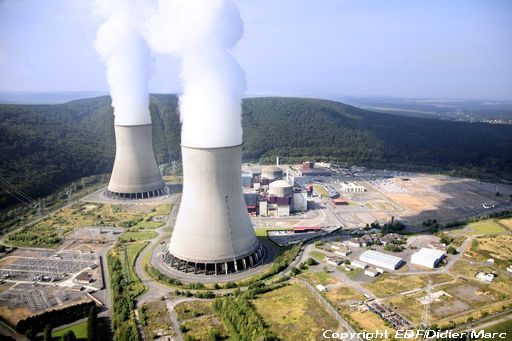
Electron-antineutrinos are abundantly produced by the nuclear fission reactions inside the reactor cores (6 νe are produced in the uranium fission induced by neutrons [Way48]). A typical ~ 1 GW standard nuclear plant radiates about 5.1020 antineutrinos per second; their energy spectrum extends to 10 MeV and their mean energy is around 4 MeV. Thanks to these properties, they have been the first to be used by Reines and Cowan to observe the “neutrino” for the first time in 1956 [Cow56] and are still used to observe neutrino oscillation and infer neutrino properties.
Antineutrinos are observed via the inverse beta decay process: an electron-antineutrino interacts with a proton to give a positron and a neutron. The threshold of this reaction is 1.8 MeV (mass difference between the neutron and the proton). After a first try in 1953, which was using this principle [Rei53], Reines and Cowan, were more successful in 1956 [Cow56].
In 1955, Ray Davis had tried unsuccessfully to detect neutrinos at the Brookhaven nuclear reactor [Dav55]. But the detection principle proposed by Bruno Pontecorvo was sensitive to neutrinos, not to antineutrinos, and Davis showed that neutrinos and antineutrinos were different: [link].
From the end of the 70’s, a series of experiments close to reactors were used to look for neutrino oscillations. The first hint has been by Reines and his collaborators in 1980 [Rei80]. They reported a 2-3σ effect, described as “Evidence for neutrino instability” in the title, and more cautiously by “indications of neutrino instability” in the abstract. This effect has not been confirmed by an experiment at the Grenoble ILL reactor [Boe80]; the same team did an experiment at the Gösgen reactor and the result was also consistent with no neutrino oscillation [Vui82]. In 1984, a high statistics experiment at the Bugey reactor showed a difference in the counting rate at two different distances from the reactor’s core, difference interpreted in terms of oscillation [Cav84]. A re-analysis of the experiment two years later cancelled the previous result. It has been followed by more precise experiments always at Bugey at different distances (but smaller than 80 m), without indication of an oscillation.
In the mid 90’s, a new generation of bigger experiments was built at a larger distance (about 1 km), to test oscillation parameters in a lower Δm2 region. The best result came from the Chooz experiment [Apo98,Apo99], confirmed later by Palo Verde [Boe00].


After the discovery of neutrino oscillation in the atmospheric sector (1998) and in the solar sector (2001), it became mandatory to measure the third mixing angle,θ13, to complete the PMNS mixing matrix. Chooz had already put a very constraining limit on this parameter (which was in any case much smaller than θ12 and θ23 , which values were close to the maximal). The idea to build two identical detectors (to reduce systematic errors), one close to the detector (~ 100 m), the other at a larger distance (~ km) and to compare the two measurements was developed by the Double Chooz collaboration [Ard04], followed by Daya Bay [Guo07] in China and RENO [Ahn10] in Korea (other projects in Russia or Brazil did not succeed [Goo05]). The comparison between the measurements of the two detectors could permit to observe small values of θ13. The results arrived end 2011-early 2012 [Abe11b] [An12] [Ahn12] and have been refined since this. See the review by Suekane and Bezerra for a detailed history of reactor θ13 experiments [Sue16].
The measurement of θ13 by reactor experiments has been completed by the result of the accelerator T2K experiment, which measured νe appearance in a νμ beam [Abe11a].
Further information
During the conference on the History of the Neutrino (Sept. 5-7, 2018 in Paris) the subject of Reactor Antineutrinos was reviewed by :
- Petr Vogel (Caltech, USA) with the first experiments towards oscillation : here the slides , the video of his talk and his contribution to the Proceedings.
- Thierry Lasserre (CEA-Saclay, France) with the experiments towards the measurement of θ13 : here the slides , the video of his talk and his contribution to the Proceedings.
- Adam Bernstein (Lawrence Livermore National Laboratory, USA) described in Neutrinos for peace how the experimental techniques could be applied to monitor nuclear reactors : here the slides , the video of his talk and his contribution to the Proceedings.
- and Henry T. Wong (Institute of Physics, Taiwan) produced a written contribution to the Proceedings on the TEXONO program.
References
| Author(s) | Title | Reference | Key-words | |
|---|---|---|---|---|
| Abe11a | K. Abe et al., T2K collaboration | Indication of electron neutrino appearance from an accelerator-produced off-axis muon-neutrino beam | Phys. Rev. Lett. 107 (2011) 041801; arXiv:1106.2822 | historical accelerator oscillation properties milestonebib overviewbib reactorbib oscbib plotbib |
| Abe11b | Y. Abe et al., Double Chooz collaboration | Indication for the disappearance of reactor electron antineutrinos in the Double Chooz experiment | Phys. Rev. Lett. 108 (2012) 131801; arXiv:1112.6353 | historical reactor oscillation properties milestonebib overviewbib reactorbib oscbib plotbib detectorbib |
| Ahn10 | J.K. Ahn et al., RENO Collaboration | RENO : an experiment for neutrino oscillation parameter q13 using reactor neutrinos at Yonggwang | arXiv:1003.1391 | oscillation reactor reactorbib |
| An12 | F.P. An et al., Daya Bay collaboration | Observation of electron-antineutrino disappearance at Daya Bay | Phys. Rev. Lett. 108 (2012) 171803; arXiv:1203.1669 | historical reactor oscillation properties milestonebib overviewbib reactorbib oscbib plotbib detectorbib |
| Apo98 | M. Apollonio et al., Chooz collaboration | Initial results from the Chooz long baseline reactor neutrino oscillation experiment | Phys. Lett. B420 (1998) 397 | oscillation reactor reactorbib oscbib |
| Apo99 | M. Apollonio et al. | Limits on neutrino oscillations from the Chooz experiment | Phys. Lett. B466 (1999) 415 | oscillation reactor reactorbib oscbib detectorbib |
| Ard04 | F. Ardellier et al. | Letter of intent for Double Chooz: a search for the mixing angle q13 | arXiv:hep-ex/0405032 | oscillation reactor reactorbib |
| Boe00 | F. Boehm et al., Palo Verde collaboration | Search for neutrino oscillations at the Palo Verde nuclear reactors | Phys. Rev. Lett. 84 (2000) 3764; arXiv:hep-ex/9912050 | oscillation reactor reactorbib detectorbib |
| Boe80 | F. Boehm et al. | Experimental study of neutrino oscillations at a fission reactor | Phys. Lett. B97 (1980) 310 | oscillation reactor reactorbib |
| Cav84 | J.F. Cavaignac et al. | Indication for neutrino oscillation from a high statistics experiment at the Bugey reactor | Phys. Lett. B148 (1984) 387 | oscillation reactor reactorbib oscbib |
| Cow56 | C.L. Cowan, F. Reines, F.B. Harrison, H.W. Cruse and A.D. McGuire | Detection of the free neutrino: a confirmation | Science 124 (1956) 103, July 20, 1956 - Reprint in “Neutrino Physics”, ed. by K. Winter, Cambridge University Press, 1991 | historical detection milestonebib overviewbib discovbib reactorbib plotbib detectorbib |
| Goo05 | M. Goodman | New reactor neutrino experiments besides Double Chooz | arXiv:hep-ph/0501206 | oscillation reactor reactorbib |
| Guo07 | Xinheng Guo et al., Daya Bay Collaboration | A precision measurement of the neutrino mixing angle q13 using reactor antineutrinos at Daya Bay | arXiv:hep-ex/0701029 | oscillation reactor reactorbib |
| Rei53 | F. Reines and C.L. Cowan | Detection of the free neutrino | Phys. Rev. 92 (1953) 830 | historical detection milestonebib overviewbib discovbib reactorbib plotbib |
| Rei56 | Frederick Reines and Clyde Cowan jr. | The neutrino | Nature 178 (1956) 446 | historical detection milestonebib overviewbib discovbib reactorbib plotbib |
| Rei80 | F. Reines, H.W. Sobel, E. Pasierb | Evidence for neutrino instability | Phys. Rev. Lett. 45 (1980) 1307 | oscillation reactor reactorbib oscbib |
| Sue16 | Fumihiko Suekane and Thiago Junqueira de Castro Bezerra | Double Chooz and a history of reactor q13 experiments | arXiv:1601.08041, Nucl. Phys. B908 (2016) 74 | history reactor oscillation properties reactorbib |
| Vui82 | J.L. Vuilleumier et al. | New limits on oscillation parameters for electron antineutrinos | Phys. Lett. B114 (1982) 298 - Final results from Gösgen in G. Zacek et al. / Neutrino-oscillation experiments at the Gösgen nuclear power reactor / Phys. Rev. D34 (1986) 2621 | oscillation reactor reactorbib oscbib |
| Way48 | K. Way and E.P. Wigner | The rate of decay of fission products | Phys. Rev. 73 (1948) 1318 | reactor reactorbib |
